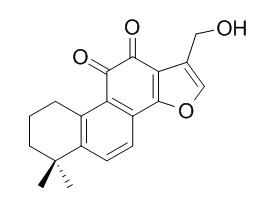Przewaquinone A
Przewaquinone A has antitumor activity.
Inquire / Order:
manager@chemfaces.com
Technical Inquiries:
service@chemfaces.com
Tel:
+86-27-84237783
Fax:
+86-27-84254680
Address:
1 Building, No. 83, CheCheng Rd., Wuhan Economic and Technological Development Zone, Wuhan, Hubei 430056, PRC
Providing storage is as stated on the product vial and the vial is kept tightly sealed, the product can be stored for up to
24 months(2-8C).
Wherever possible, you should prepare and use solutions on the same day. However, if you need to make up stock solutions in advance, we recommend that you store the solution as aliquots in tightly sealed vials at -20C. Generally, these will be useable for up to two weeks. Before use, and prior to opening the vial we recommend that you allow your product to equilibrate to room temperature for at least 1 hour.
Need more advice on solubility, usage and handling? Please email to: service@chemfaces.com
The packaging of the product may have turned upside down during transportation, resulting in the natural compounds adhering to the neck or cap of the vial. take the vial out of its packaging and gently shake to let the compounds fall to the bottom of the vial. for liquid products, centrifuge at 200-500 RPM to gather the liquid at the bottom of the vial. try to avoid loss or contamination during handling.
FEBS Lett.2021, 595(20):2608-2615.
Foods.2024, 13(11):1739.
Int J Mol Sci.2023, 24(7):6360.
Molecules.2017, 22(12)
Biochem Systematics and Ecology2017, 11-18
Antioxidants2022, 11(2),234.
J Cell Physiol.2020, 10.1002
Int J Cosmet Sci.2019, 41(1):12-20
Cancers (Basel).2023, 15(1):293.
Life Sci.2023, 317:121458.
Related and Featured Products
Chemosphere. 2013 Oct;93(6):997-1004.
Algicidal activity of Salvia miltiorrhiza Bung on Microcystis aeruginosa--towards identification of algicidal substance and determination of inhibition mechanism.[Pubmed:
23810520]
The present study was to isolate and identify a potent algicidal compound from extract of Salvia miltiorrhiza and study the potential inhibition mechanism on Microcystis aeruginosa.
METHODS AND RESULTS:
Column chromatography and bioassay-guided fractionation methods were carried out to yield neo-Przewaquinone A, which was identified by spectral analysis. The EC50 of neo-Przewaquinone A on M. aeruginosa were 4.68 mg L(-1). In addition, neo-Przewaquinone A showed relatively higher security on Chlorella pyrenoidosa and Scenedesmus obliquus, with the EC50 values of 14.78 and 10.37 mg L(-1), respectively. For the potential inhibition mechanisms, neo-Przewaquinone A caused M. aeruginosa cells morphologic damage or lysis, increased malondialdehyde content and decreased the soluble protein content, total antioxidant and superoxide dismutase activity, and significantly inhibited three photosynthesis-related genes (psaB, psbD, and rbcL).
CONCLUSIONS:
The results demonstrated the algicidal effect of neo-Przewaquinone A on M. aeruginosa and provided the possible inhibition mechanisms.



